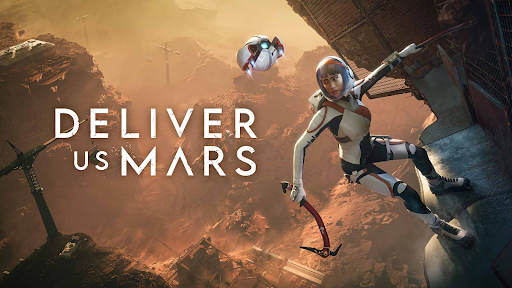Deliver Us Mars: Game Review

Space-related games are making a resurgence in the gaming world. The remake of Dead Space, The Callisto Protocol, and even the upcoming Aliens: Dark Descent. Instead of the usual action-heavy horror approach, developers KeokeN chose a more peaceful narrative approach with their latest project, Deliver Us Mars.
For those unfamiliar, Deliver Us Mars is a sequel to 2018’s Deliver Us The Moon. Both games are narrative-driven adventure games that focus heavily on puzzle-solving and platforming.
In many ways, this follow-up is more ambitious and improved upon compared to its predecessor, but in other ways, this game suffers from the same flaws. Let’s review this game.
Storyline
In Deliver Us Mars, we get to see the future, which is set ten years after the events of Deliver Us The Moon. You play as the protagonist, Kathy Johanson, an astronaut sent on a mission to Mars after a distress signal is received. It’s been ten years since the Fortuna trip to the Moon to attempt to fix Earth’s energy problems failed, and now humanity is on the verge of extinction. After receiving a distress signal, which serves as the catalyst to send yet another crew into space to go and investigate. Earth’s atmosphere is dying, and Mars holds vital information on reversing climate change and houses recolonization ships called ARKs.
Deliver Us Mars tells a much more fraught and personal tale of what kind of future humanity should be pursuing: should we, in fact, be turning our efforts towards life in outer space, or should we be doing everything in our power to try and save the dire, pretty much dead husk of a planet we call home?
Deliver Us The Moon turned out to be a successful title, and for that reason, KeokeN didn’t hesitate to set a lofty goal and expand the project’s scope. Deliver Us Mars mostly maintains this positive tone while keeping the game’s basic structure, which is dressed up in a more sophisticated theatrical fashion.
Gameplay
Deliver Us Mars takes you through multiple chapters of puzzle-based adventure gameplay, which essentially boils down to either connecting a beam of power to an electric point to continue the mission further or using two climbing picks to work your way around the environment.
The beam puzzles prove to be fun, however, over time, they end up feeling a bit samey. It would have been interesting to see another element added to them or a different kind of solution to solve the puzzle entirely.
The inclusion of verticality distinguishes this sequel from Deliver Us to the Moon and Mars. As a player, you are equipped with handy climbing axes to navigate the red planet’s rocky surfaces. Climbing can be initially difficult to grasp which tends to be slightly frustrating, especially while using a mouse and keyboard. Once you’re used to it, though, it proves to be a solid gameplay mechanic.
Only certain surfaces in the game are climbable, and they’re all visually distinct, so, you’ll know when you see them. The surfaces are designed such that you have to be careful where you land your next pickaxe thrust. It’s a nice change of pace, to say the least, and a welcome addition to gameplay.
In the game, Kathy also has a floating robot pal called Ayla, who gets a bit of a short straw here compared to their Moon counterpart, Ace. The counterparts appear to be sidelined as the game favours beam puzzles. Although, the few puzzle assistance methods Ayla does provide—hovering through vents to open locked doors and peeking into different rooms—are lifted pretty much wholesale from Mars’ predecessor,
As such, Ayla’s abilities never really move forward as you might expect them to in a sequel, and they end up feeling more like a glorified hologram projector than anything else. Deliver Us The Moon had a major flaw, which was its terrible checkpoint and saving system. Unfortunately, the developers haven’t learned from past criticism, and just like the first game, Deliver Us Mars lacks a manual save option.
The auto-save checkpoints aren’t too far apart, but if your game crashes, you need to reboot your console, or you want to play another game, then get ready to waste time getting back to where you were because your current progress will be lost.
This situation is significantly exacerbated when you launch the game from scratch and accidentally press the “New Game” option on the main menu because your cursor defaults to it. Unfortunately, this will completely override your previous auto checkpoint because there is no “Load Game” option. Thankfully, there is a “Chapter Select,” but that forces you to start over from the beginning of a chapter, still wasting time.
Graphics
Climbing tends to be a tedious task in the title’s gameplay, however, what makes it enjoyable are the game’s environments. Deliver Us Mars has some gorgeous visuals. From the dying Earth to the red planet itself, you get to see a lot of different landscapes that are worth taking a moment to appreciate.
The odd character models juxtapose these grand visuals and environments as Kathy and our main team are mostly clear on this. But, the other human character models in the game tend to come across as quite uncanny and can detract from the immersion as you struggle to connect the strange face in front of you to a human being.
With impressive voice performances and dialogues, Deliver Us Mars doesn’t detract too much from the overall experience. The character models do feel like they are lodged in gaming’s past, whereas the rest of the visuals hold up against a lot of other modern titles.
Verdict
Deliver Us Mars has a strong narrative core running throughout most of it, supported by great voice performances, especially from Ellise Chappell who plays Kathy, and there’s some solid gameplay and impressive visuals thrown into the mix as well.
Despite its good points, there are a few key factors that leave Deliver Us Mars in a state of being very good rather than great. Even with its many strengths, it has enough to hold it back from reaching a higher score.

